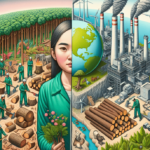Georgia-Pacific vs Stora Enso: A Comprehensive Comparison
The paper and packaging industry is a highly competitive and rapidly evolving space, where companies are constantly striving to outperform each other. Two prominent contenders in this industry are Georgia-Pacific and Stora Enso. In this article, we delve deep into the strengths, weaknesses, business models, products, financial performance, and social responsibilities of these two companies, along with their future prospects in the industry.
Understanding the Paper and Packaging Industry
The paper and packaging industry comprises various segments, including graphic paper, packaging paper, tissue, and pulp. The industry is characterized by high capital investments, fluctuating raw material prices, stringent environmental regulations, and volatile demand. Key factors driving demand in this industry include increasing urbanization, the rise of e-commerce, and the push for sustainable packaging solutions.
One of the major challenges faced by the paper and packaging industry is the increasing competition from digital media. With the rise of digital platforms, the demand for paper-based products has declined significantly. However, the industry has responded by developing innovative products and solutions, such as smart packaging and eco-friendly materials, to stay relevant in the market.
According to a Mordor Intelligence report, the global paper and packaging market is expected to grow at a CAGR of 4.2% from 2023 to 2028, driven by technological advancements and sustainable practices.
Company Analysis: Georgia-Pacific and Stora Enso
Overview
Georgia-Pacific is a privately-held company based in Atlanta, Georgia, specializing in producing and distributing tissue, pulp, paper, packaging, and building products. The company operates over 180 facilities across North America, Europe, and Asia and employs more than 30,000 people.
Stora Enso, on the other hand, is a publicly-traded company headquartered in Helsinki, Finland, operating in the pulp and paper, packaging, biomaterials, wood products, and energy sectors. The company has operations in over 50 countries and employs approximately 25,000 people.
Both Georgia-Pacific and Stora Enso are major players in the global paper and packaging industry. Georgia-Pacific is renowned for its consumer brands such as Brawny, Angel Soft, and Dixie, while Stora Enso is recognized for its sustainable and innovative products, including biodegradable packaging and wood-based textiles. Despite differences in ownership and product offerings, both companies prioritize sustainability and responsible sourcing in their operations.
History and Evolution
Founded in 1927, Georgia-Pacific has undergone several mergers and acquisitions over the years. The acquisition by Koch Industries in 2005 enabled it to expand its product portfolio and geographical reach.
Stora Enso boasts a long history dating back to the 13th century. Formed through the merger of Stora and Enso in 1998, the company has since made significant investments in research and development, sustainable operations, and strategic mergers and acquisitions to maintain its competitive edge.
Both companies have emphasized sustainability in recent years. Georgia-Pacific committed to sourcing 100% of its wood fiber from certified sustainable sources by 2020, and Stora Enso aims to become carbon neutral by 2030. These commitments are in line with industry trends towards environmental responsibility.
Business Models and Strategies
Georgia-Pacific employs a decentralized business strategy, allowing each business unit to operate independently and develop its own products and brands. The company focuses on operational efficiency, waste reduction, and sustainable practices to enhance its profitability.
Stora Enso adopts a more centralized business model with a strong emphasis on the circular economy, customer-centric innovation, and digitalization. The company aims to create sustainable, profitable growth by investing in emerging markets, new technologies, and value-added products.
Despite differing business models, both companies are committed to reducing their environmental impact. Georgia-Pacific has implemented a closed-loop system for its paper mills, reusing or recycling waste, and invested in renewable energy sources such as biomass and wind power. Stora Enso has set ambitious targets to reduce greenhouse gas emissions and has developed innovative products like biodegradable packaging materials.
Products and Innovations
Georgia-Pacific's product portfolio includes paper towels, bath tissue, napkins, facial tissue, and copy paper, along with corrugated packaging and building products. Popular brands include Quilted Northern, Angel Soft, Brawny, and Dixie.
Stora Enso offers a wide range of products, including containerboard, cartonboard, pulp, wood products, reconstituted lignin, and biomaterials. The company is renowned for its sustainable offerings, such as the DuraSense range of biocomposites and the ECO platform of renewable packaging solutions.
Both companies prioritize sustainability in their operations. Georgia-Pacific aims to reduce its greenhouse gas emissions by 25% by 2025 and has implemented sustainable forestry practices to ensure responsible wood fiber sourcing. Stora Enso targets carbon neutrality by 2035, invests in renewable energy sources like wind power and biomass, and collaborates with suppliers to ensure responsible raw material sourcing. Additionally, Stora Enso employs circular economy principles to minimize waste and promote recycling.
Financial Performance
Financial performance is a critical aspect of any company's success. In the latest fiscal reports, Georgia-Pacific reported revenues of $22.0 billion and a net income of $950 million, while Stora Enso reported revenues of €9.0 billion and a net income of €620 million. Both companies have maintained healthy growth rates, with Georgia-Pacific's revenue growing at a CAGR of 3.5% between 2018 and 2023, and Stora Enso's growing at a CAGR of 2.5% during the same period.
When examining profitability ratios, Stora Enso outperforms Georgia-Pacific. Stora Enso's gross profit margin for the latest fiscal year was 28.0%, compared to Georgia-Pacific's 25.0%. Additionally, Stora Enso's return on equity (ROE) stood at 12.0%, while Georgia-Pacific's ROE was 9.0%. This indicates that Stora Enso is more efficient in generating profits from shareholder investments.
Both companies have faced industry-specific challenges. Georgia-Pacific has been impacted by the declining demand for certain paper products, while Stora Enso has navigated the shift towards digitalization and the rise of e-commerce. In response, both companies have diversified their product offerings and invested in new technologies to maintain competitiveness.
For detailed financial insights, refer to the Stora Enso Financial Reports and the Georgia-Pacific Financials.
Corporate Social Responsibility
Sustainability and social responsibility are critical aspects of modern businesses. Both Georgia-Pacific and Stora Enso have implemented sustainable practices to reduce their environmental impact and contribute to the communities they operate in.
Georgia-Pacific has set an ambitious goal to reduce its greenhouse gas emissions by 30% by 2030. The company has also implemented water conservation strategies and waste reduction programs, demonstrating its commitment to environmental stewardship.
Stora Enso has launched several sustainability frameworks, such as the Renewable Packaging approach, to promote sustainable forestry, reduce emissions, and create circular production models. These initiatives align with global sustainability standards and highlight the company's dedication to long-term ecological balance.
For more information on their CSR initiatives, visit the Georgia-Pacific Sustainability Page and the Stora Enso Sustainability Page.
Competitive Landscape of the Paper and Packaging Industry
The paper and packaging industry is highly competitive, with numerous players vying for market share. Prominent competitors of Georgia-Pacific and Stora Enso include International Paper, WestRock, Mondi, UPM-Kymmene, and Domtar. These companies compete based on price, quality, innovation, and sustainability.
One major challenge is the increasing demand for eco-friendly and sustainable products. Consumers are more environmentally conscious, seeking products made from recycled materials and those that are biodegradable. This shift has led the industry toward sustainable practices and the development of innovative products to meet these demands.
Another factor shaping the competitive landscape is the rise of e-commerce. With more consumers shopping online, there's a growing need for packaging that is both sustainable and designed to protect products during shipping. This trend has spurred the development of new packaging materials and designs tailored to e-commerce needs, creating opportunities for industry players.
Financial Performance Analysis
Financial performance is a critical aspect of any company's success. In the latest fiscal reports, Georgia-Pacific reported revenues of $22.0 billion and a net income of $950 million, while Stora Enso reported revenues of €9.0 billion and a net income of €620 million. Both companies have maintained healthy growth rates, with Georgia-Pacific's revenue growing at a CAGR of 3.5% between 2018 and 2023, and Stora Enso's growing at a CAGR of 2.5% during the same period.
When examining profitability ratios, Stora Enso outperforms Georgia-Pacific. Stora Enso's gross profit margin for the latest fiscal year was 28.0%, compared to Georgia-Pacific's 25.0%. Additionally, Stora Enso's return on equity (ROE) stood at 12.0%, while Georgia-Pacific's ROE was 9.0%. This indicates that Stora Enso is more efficient in generating profits from shareholder investments.
Both companies have faced industry-specific challenges. Georgia-Pacific has been impacted by the declining demand for certain paper products, while Stora Enso has navigated the shift towards digitalization and the rise of e-commerce. In response, both companies have diversified their product offerings and invested in new technologies to maintain competitiveness.
For detailed financial insights, refer to the Stora Enso Financial Reports and the Georgia-Pacific Financials.
Corporate Social Responsibility Practices
Sustainability and social responsibility are critical aspects of modern businesses. Both Georgia-Pacific and Stora Enso have implemented sustainable practices to reduce their environmental impact and contribute to the communities they operate in.
Georgia-Pacific has set an ambitious goal to reduce its greenhouse gas emissions by 30% by 2030. The company has also implemented water conservation strategies and waste reduction programs, demonstrating its commitment to environmental stewardship.
Stora Enso has launched several sustainability frameworks, such as the Renewable Packaging approach, to promote sustainable forestry, reduce emissions, and create circular production models. These initiatives align with global sustainability standards and highlight the company's dedication to long-term ecological balance.
For more information on their CSR initiatives, visit the Georgia-Pacific Sustainability Page and the Stora Enso Sustainability Page.
Innovations and Technological Advancements in the Paper and Packaging Industry
The paper and packaging industry is undergoing significant transformation due to technological advancements and innovations. Companies are increasingly adopting automation, robotics, and digitalization to optimize operations and improve efficiency.
Georgia-Pacific has invested in technologies such as blockchain and artificial intelligence to enhance traceability and improve supply chain transparency. These technologies help ensure responsible sourcing and streamline operations.
Stora Enso has launched several digital initiatives, including the Intelligent Packaging Service, which enables customers to track and analyze their packaging operations in real-time. Such innovations not only improve operational efficiency but also provide valuable data insights for continuous improvement.
According to a recent study by McKinsey & Company, digital transformation is expected to increase productivity in the packaging industry by up to 20% over the next five years.
The Impact of COVID-19 on the Paper and Packaging Industry
The COVID-19 pandemic disrupted global supply chains and caused significant upheaval in the paper and packaging industry. While segments such as tissue and packaging saw increased demand due to heightened hygiene concerns and a surge in e-commerce, other segments like graphic paper experienced a decline.
Georgia-Pacific and Stora Enso implemented numerous precautionary measures to protect their employees and ensure business continuity. Both companies also played a role in the fight against COVID-19 by producing critical supplies such as hand sanitizers, face masks, and medical-grade packaging.
Despite the challenges, the pandemic accelerated digital transformation and sustainability initiatives within the industry, positioning companies to better navigate future disruptions.
Future Prospects for Georgia-Pacific vs Stora Enso
The paper and packaging industry is poised for significant opportunities and challenges in the future, influenced by changing consumer preferences, digitization, sustainability concerns, and evolving regulations.
Georgia-Pacific aims to increase its market share in the growing tissue and packaging sectors, diversify its product portfolio, and enhance operational excellence through digitalization and automation.
Stora Enso intends to double its biomaterials business by 2025, increase its share of renewable packaging solutions, and leverage emerging technologies such as 5G and artificial intelligence to create value for its customers.
Both companies are expected to continue their focus on sustainability and innovation to address the dynamic market demands and regulatory landscapes.
Key Takeaways from the Georgia-Pacific vs Stora Enso Battle
The competition between Georgia-Pacific and Stora Enso highlights the fierce rivalry and continuous innovation within the paper and packaging industry. Georgia-Pacific emphasizes operational excellence and strong brand recognition, while Stora Enso focuses on sustainable growth and digital innovation.
Both companies possess unique strengths and face distinct challenges, necessitating ongoing evolution to thrive in the industry's rapidly changing environment.
Expert Opinions on the Future of the Paper and Packaging Industry
The future of the paper and packaging industry remains uncertain, influenced by various macro and microeconomic factors. Experts predict significant consolidation, with larger companies acquiring smaller players to enhance market reach and capabilities. Sustainability is expected to become a key differentiator, with companies investing heavily in eco-friendly materials and processes.
Digitalization will continue to transform production and distribution, enabling greater efficiency and customization. Additionally, regulatory changes aimed at reducing environmental impact will drive innovation and necessitate compliance.
For more insights, refer to expert analyses from sources like Wood Business News and Packaging Strategies.
Conclusion: Who Will Emerge Victorious in the Battle Between Georgia-Pacific and Stora Enso?
The ongoing competition between Georgia-Pacific and Stora Enso is set to continue for years to come, with both companies navigating their unique opportunities and challenges. The ultimate victor will be the company that can adeptly adapt to changing market demands, create sustainable value for its customers, and keep pace with the technological revolution sweeping the industry.
Success will hinge on each company's ability to innovate, prioritize sustainability, and respond swiftly to emerging trends and disruptions.






















